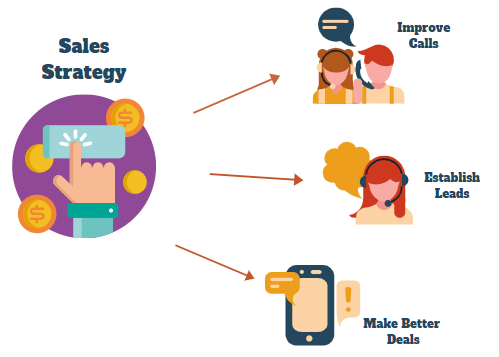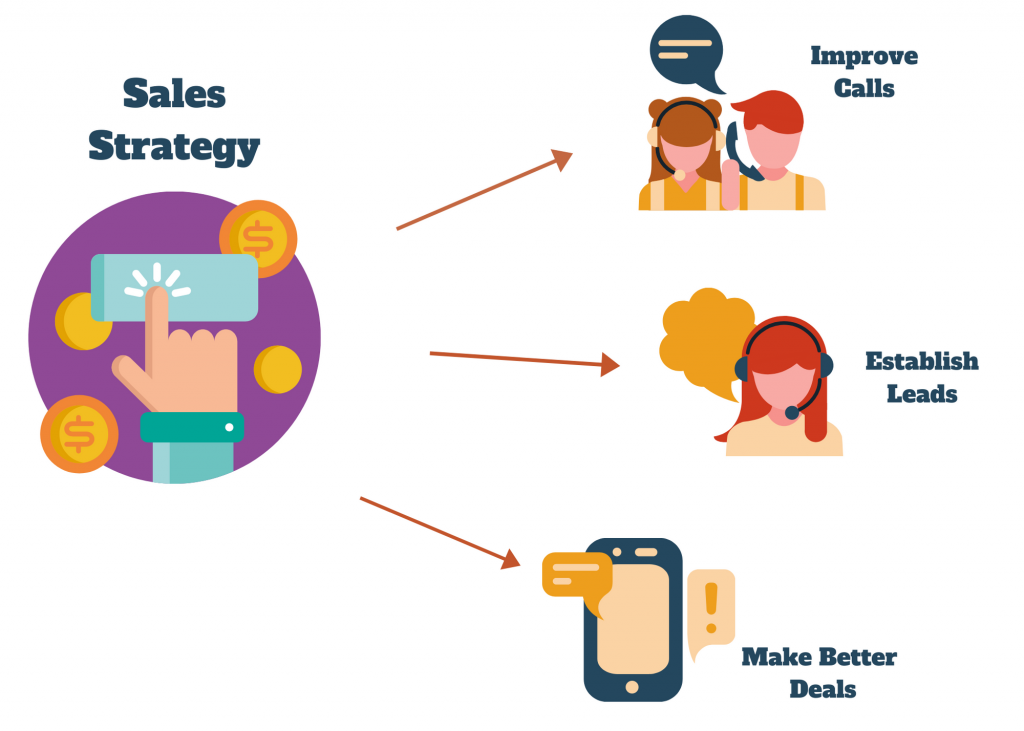10 Dec

What is a Sales Strategy And Why Do You Need It?
A sales strategy is a documented plan that states what your company is selling, who you are selling to, and the methods for selling those products or services in a way that makes your company have a differentiated advantage. The sales strategy will also need to give specific objectives and goals in order for the sales staff to be successful and have clear expectations. Having great dialing software, such as a power dialer, is a critical aspect, but without a sales strategy, your calls might not be effective.
There are no successful companies that do not have a sales strategy. Therefore, your company should be no exception. Make a sales strategy that leads your company to success and create an environment in your company that values the sales strategy.
Of course, you may already have a sales strategy but you might need to revise it. In another article, we’ve collected 5 key questions to answer during a quarterly sales review, that will help you evaluate your sales strategy and guide whether you need to revise it or not. If you’re not already doing quarterly reviews, you should definitely include this in your plan. Answering these questions will help your company determine what the successful parts of your sales strategy are and what parts need some work.
How to Improve Your Existing Sales Strategy?
It is likely that your company already has a sales strategy, but how long ago was the strategy made? With time, the company’s sales strategy can go stagnant and become outdated. The revised sales strategy, however, should strive to reflect the company’s direction and speed at which it’s going.
Not everything in the sales strategy will need to be changed, but then again if it hasn’t been revised since it was made, it might all need improvements. Begin by reviewing the companies sales strategy and asking the questions:
- What is meeting the company’s goals and what is not?
- What engages our ideal customers and what does not?
- What changes have happened in the market since the company established its sales strategy?
As you ask these questions, make note of the answers, to make the revision process easier. Next, invest in market research to see in what ways the market and your ideal customer have changed. After thorough research, the company should review the marketing strategy and make changes to reach the ideal customer for the product/service being offered.
Is the company differentiated enough from its competitors? If the answer is no, focus on marketing the result of the product instead of the product itself. The sales strategy must align with the marketing strategy as it changes and must differentiate itself in order to be successful. Here are the sales strategy topics that will be included:
- What is a Sales Strategy and Why Do You Need It?
- A sales strategy is a documented plan that states what your company is selling, who you are selling to, and the methods for selling those products or services in a way that makes your company have a differentiated advantage.
- How to Improve Your Existing Sales Strategy?
- Determine what is successful in the sales strategy and what is not, then use market research about the industry and the ideal customer to revise the parts of the strategy that are unsuccessful.
- Set Goals For Your Sales Strategy
- Give achievable, well-communicated activity goals, result goals, and benchmarks.
- Define Your Position as Part of Your Business Sales Strategy
- Using a SWOT (strengths, weaknesses, opportunities, threats) Analysis and a Perceptual Map will help your company define its position in the sales strategy as well as its position in the market.
- Improve Messaging as Part of Your Business Sales Strategy
- Use a SWOT (strengths, weaknesses, opportunities, and threats) Analysis and a Perceptual Map to categorize the company, then make a message that aligns with the results of the analysis and map. Use the dialogue to convey the message.
- Improve Leads Qualification as Part of Your Business Sales Strategy
- Research prospects before cold calling, follow a script, track questions/objections, and speed up your calling process.
- Improve Calling as Part of Your Business Sales Strategy
- Determine prospects, common questions, a script and how to improve calling overall.
- Hire The Right People To Achieve The Goals in Your Sales Strategy
- Look for people who are problem solvers, good listeners, and able to convey the company’s message
- Final Step of Your Sales Strategy: Write a Sales Plan
- Write a thorough plan using the data and information that you have acquired about your company.

Set Goals for Your Sales Strategy
When setting goals for your sales strategy, make sure they are achievable within that time period and be sure employees of the company know what the goals are. Giving achievable, well-communicated goals helps create motivation by helping employees envision the finish line on each goal. Furthermore, each goal needs to guide the leads further down the sales pipeline to retain more sales and ensure a satisfied customer.
There are seven stages in the sales process:
- Prospecting: Finding and qualifying potential customers by determining if the customer has a need or want that the company can supply and determining if the ideal customer can afford it.
- Preparation/Qualification: Preparing for the first contact with the customer. This will require research on relevant data like the product description, price range, and the competitors approach as well as if the potential customer needs the product, can afford it, etc.
- Approach: Making contact with the customer in one of the three ways:
- The Premium Approach: Where you give the potential customer a gift. (EX: a pen or key chain)
- The Question Approach: Where you ask the potential customer a question that appeals to the needs/wants. (EX: Would you like to have an all inclusive package for half the price?)
- The Product Approach: Where you give a sample of the product you are trying to sell them. (EX: Giving a free trial to use your companies portal)
- Presentation: Listening to the customers needs and wants, then explaining how the product can service those needs or wants to the customer.
- Objections: Objections will occur, but it is important that the employee tries to resolve and understand those objections so they can meet the customers needs or wants.
- Closing: When the customer gives indications that they are going to make their decision. There are three approaches to closing:
- The Alternative Choice Close: The employee will assume that the customer is ready to pay and will ask how they would like to pay. (EX: What form of payment will you be using for this purchase?)
- The Extra Inducement Close: The employee will offer the customer something more if they purchase right away. (EX: If you buy today, I can offer a 10% discount.)
- The Standing Room Only Close: The employee urges the customer to buy now, because in the future the price won’t be that low or because an event is about to occur. (EX: This is our last act sale, so we won’t be able to offer this price in the future.)
- Follow-up/Feedback: The employee will call or email the customer to ask how they like the product and solidify the customer-employee relationship for future purchases from the customer.
Once you have determined the goals, carefully craft these stages for your business and for your pipeline. Remember that the pipeline is a necessity, not a luxury, so you will want to be precise on how you use it. Then use the information to implement the pipeline because each stage requires a different approach, messaging, content, and, most importantly, unique sales activities. The objections and obstacles you’ll come across will also vary, which is why setting goals for every stage is key.
Establish Activity Goals for Each of the Sales Stages
The activity goals for a company refer to the process required to take a sales opportunity to the next stage of the sales process. It is focused on the activities you do to achieve results, not the results themselves. For example, emailing the customer or giving the customer a follow-up call. These are goals that can be assigned to employees and can be checked off a list, hence, activity goals.
Introducing a software that monitors and records your calls will help in tracking the number of calls, as well as other activity goals that are assigned. The Power Dialer is one great example of a software that does this.
Establish Result Goals for Each of the Sales Stages
Results Goals refer to a quantity of tasks accomplished through tracking the number of appointments/meetings made, the number of sales made, new trials processed, revenue collected, etc. Success here is measured in the quantity of each task. It is easier to tell how successful result-based goals are because you can see reactions from the potential customer, and generally this is going to be a better way to track your overall performance.
Create Benchmarks Based on Previous Sales Performance
A benchmark is a point of reference that the company can compare to or use to assess where they should be. Your company’s benchmark might be the number of sales you received last year at this same time. Typically businesses use benchmarks to determine what a reasonable amount would be to achieve a higher number of sales in the present year. Your company can start by looking at the previous sales reports and asking questions like:
- How many sales were made last year?
- What revenue was brought in and how much profit was that?
- Were most of the sales one-off purchases or did the company attract a collection of long-term clients?
- What was the longest, and the shortest, sales cycle that a client had with your business?
- Which members of your team made the most sales? To whom did you sell the most?
- Which of your clients brought in the most revenue?
- Where should you look for growth?
- What will your team need to achieve your new goals?
Answering these questions will help in determining what goals you want to set for the upcoming months/years.
DETAILED RESOURCES:
- Free Sales Report Template
- Sales Call Reporting Template
- 9 Call Metrics That Sales Managers Should Track
Define Your Position as Part of Your Business’ Sales Strategy
Defining your company’s position in its sales strategy requires an analysis of the companies strengths and weaknesses. A SWOT Analysis helps a company define their strengths, weakness, opportunities, and threats. This will help your company determine where they fit on the Perceptual Map for competitive analysis as well as help the company understand what can offer their ideal customer. Your company will not always be able to offer everything the customer is looking for, sometimes it’s best to specialize in one area rather than be moderate in several areas.
Do a Competitor Analysis
A competitive analysis is where your company defines the top competitors and researches their products, sales, and marketing strategies. Which the company then uses to better construct their own companies strategies. Another benefit to a competitive analysis is understanding how your company can better differentiate from the competitors.
Create Your Positioning Map
To create your own map, start with the two variables that make the most sense for the company’s brand and solution. Common positioning variables include:
- Quality
- Price
- Market share
- Complexity
- Market perception
- Practicality
Once you have chosen the variables, use the map to place their competitors and evaluate the company’s market position.
Identify Your Target Market Segment
Identifying your target market segment requires that the company focuses solely on the unique buyer persona for the company instead of everyone else’s buyer personas. It becomes difficult for salespeople to sell when the company doesn’t fully understand its niche and doesn’t understand their customer. This is why it is advantageous for your company to target a specific segment of the market to focus on. If you can gain attention in that segment of the market and offer the best services/products in that segment you will be better off then trying to have your feet in two market segments at once. Of course, once your company is well established in the segment market and well known, then there will be opportunities to enter other market segments and the company will have a better chance at success.
Improve Messaging as Part of Your Business’ Sales Strategy
Messaging is extremely important for sales, especially when it comes to communicating over the phone or through email. So, whether your company has a written dialogue or gives employees liberty to communicate as they see fit, be sure that the message the company wants to communicate is well received by the customers.
Define and Communicate Your Unique Competitive Advantage
Using the Perceptual Map and the SWOT analysis will be necessary when defining and communicating your company’s unique competitive advantage. When your company knows where they place among the perceptual map, it helps categorize the company and guide in future decision making. The SWOT analysis then defines the company’s strengths and weaknesses, which is then used to the company’s advantage in the sales strategy. For more information regarding defining and communicating your company’s unique competitive advantage read this article by Moz.
Be Helpful, Not Pressuring in Your Communication
Throughout the entire sales process you must remain helpful and provide relevant information. It is important to make the sale but it is also important to create loyal customers. Your company might want to allow for unique dialogue or a list of different dialogue options so the salespeople can choose different approaches that suit the customer better. Companies too often forget to sell to the individual and try to sell to a mold of what their ideal customer looks like. To avoid this problem, have the salespeople ask questions like “What made you want to leave the competitor?” or “What interests you about our company?” These questions will help the salesperson better identify how to help the customer as well as not sound pressuring in their communication.
Build Authority in Your Messaging
In our article How to Help Your Agents Sound More Confident on the Phone we’ve covered tips on how you, as a manager, can contribute to the performance of your agents when it comes to building authority. One of the best tips you’ll find there and one of the most important ones is to offer proper training. You have to invest in your team so it can invest in your business. There are 3 main steps towards achieving authority in your messaging:
- Collect evidence (Show them how you’ve solved their problem in the past)
- Create content (It’s a great way to attract new leads while nurturing existing opportunities)
- Address criticism head-on (Take note of it and promise to make advances to fix the issues)
Improve Leads Qualification as Part of Your Business Sales Strategy
If your company is wanting a way to improve the leads qualification process, you might want to use a ‘pipeline’ as previously discussed. The pipeline allows the salespeople and management to see where prospects are in the sales process. To start a pipeline the salespeople need to create a thorough list of prospects with contact information and any other information about them that can be gathered. Make a goal of how many prospects need to be converted to customers from the completed list of prospects. Now that the sales people have a goal, they use a step-by-step sales process that also allows for unique dialogue to customize the service and make the sale. In the pipeline you will be able to refer back to the 7 Stages of the Sales Process to see where each prospect’s progress is.
Define How to Qualify Leads
Through the gathered list of potential clients, consider if they need this product or service, consider if it’s within their price range, and consider why they would choose your company’s service over your competitors. If your prospects need the product or service, can afford it, and would benefit from your company’s service then send the prospect to the next step in the sales process and make contact.
DETAILED RESOURCES:
Define How to Disqualify Leads
If you discover that a prospect is not in the market for your product or service, cannot afford it or are looking for a product of higher quality/value than yours, you can disqualify these leads. A good salesperson will be able to spot the difference from a prospect who just needs convincing and from a prospect who is looking in another area of the perceptual map. Sometimes a prospect might fit the requirements but is not ready for the purchase now. That’s okay, but make note of it and try to gauge a timeline of when they will be able to make a purchase, so your company can maintain a relationship and contact them again at the appropriate time.
Improve Calling as Part of Your Business Sales Strategy
Incorporating cold calling into your sales strategy may seem simple, but it’s important you put a lot of thought behind it before implementing, or you’ll simply be wasting time and money. There are many things to consider when preparing for a cold calling campaign in the modern era, and we’ll go through a number of them. It’s vital that you have a strategy in place and pay attention to the details.
Research Your Prospects Before Cold Calling
The research needed before you start cold calling will largely depend on the type of business you have. If you’re cold calling consumers for example, you’ll need to think about what demographic is appropriate to try to reach. Are you looking for home-owners that may be interested in buying solar panels? Does your target audience have a certain income level or credit score? For leads by demographics, www.TelephoneLists.biz is a great and affordable resource. When calling consumers, you’ll have to expect to get a lot of voicemails and not in service numbers, so you’ll need the right dialer software to make calling much more efficient. This is actually one of the telemarketing best practices. In some cases you can find pre-qualified leads that are looking for something very specific, but these will be more expensive and you’ll need to thoroughly test this to make sure it’s sustainable.
If you’re selling B2B (business to business), the answer rates should be much better, but you still need to know who you’re calling. Commonly, you can target by industry or size of the business. If you’re calling specific businesses, make sure you research contacts at the business and check them out on LinkedIn. Research your prospects when possible so you can apply some personal approach.
DETAILED RESOURCE:
- 5 Best Telemarketing Lists Brokers
Follow a Cold Calling Script
To write an effective cold calling script, you must have a good understanding of what you’re trying to accomplish on the call. Then it’s just a matter of forming the right strategy using human psychology and known successful tactics to win your prospect over.
Here’s an example of an insurance cold calling script courtesy of TelephoneLists.biz:
“Hi! I work for –insert company name- I believe I can save you a lot of money and offer great value. Do you have a moment to discuss insurance with me?”
Now if they decline, you may thank them for their time, and continue to the next prospect. If they say yes, you may continue…
“Excellent! Are you currently insured?”
No matter what they say here, you want to respond with…
“Have you considered –insert company name-? We save people an average of 15%.”
Again, no matter what they say, respond with…
“Well we’re a company that offers the biggest deals with the best coverage, and –insert more details here- so if you’re looking for better insurance, we can promise that we’re the best option around. Would you be interested in moving forward with us?”
If they answer no, try to sell them on it again. If they continue to respond negatively, thank them for their time, and move on to the next prospect. However, if the response is positive…
“That’s great! I can send you through to one of our insurance agents, would you like that? Or would you prefer I take your information and have them ring you at another time?”
If they want to be patched through, thank them for their time and send them through to someone who can take their order, if they want to be called at a later time, get their number and again, thank them for their time.
Let’s go over some of the basics:
- Introduction: State who you are and why you’re calling. Keep it short and sweet.
- Opener: Use personalization (like in the example above) to connect with them early on. Mention something you share in common if applicable.
- Reason: Why are you calling? Why should they pay attention, and how can you help them?
- Offer: What’s your value proposition? Who do you work with and how have you helped them get results?
- Questions: Gauge their interest and use qualification questions to see if they’re a good fit.
- Close: Provide a call-to-action and lead the conversation towards the next step of the sales process. Follow-up call? Meeting? Order form? Email? Credit card details? Etc.
DETAILED RESOURCES:
- How to Close a Sale Over the Phone?
- Selling Over the Phone Tips
- Phone Sales Tips
- How Can Sales Reps Increase Customer Loyalty?
- What to Do When a Prospect Says “I don’t have the money”?
- What to Do When a Prospect Says “I need to think about it”?
Collect Common Questions and Objections When Cold Calling
Have your agents keep track of the frequently asked questions or common objections so they are prepared for them. If you use a dialer with scripting ability you may be able to have dynamic scripts to address objections. Being able to go back and listen to recordings is also valuable. A power dialer such as Dolphin offers cloud recording along with coaching and monitoring tools.
Improve Your Cold Calling Timing
When you get all the little details right, things can start to compound in your favor and you’ll see better results and more success. One of those little things to consider, is choosing the right times to make your calls. This can vary depending on who your target audience is, but there are also some obvious general rules like paying attention to time zones so you aren’t calling anyone too early or too late.
DETAILED RESOURCE:
Speed Up Your Follow-Up Calling Process
Following up promptly on call-backs will make a huge difference on your conversion rate. You’ll need a system that not only can speed up your dialing, but also manage your follow-up process in an efficient manner. In addition to allowing for 40-80 calls per hour, Dolphin Cloud Power Dialer & CRM allows you to set callbacks that can be made and handled with just a click. If you don’t use a traditional dialer, make sure you have an intelligent, organized method for tracking and ensuring you follow up by phone on the prospects you need to.
If you’re generating inbound leads from your website, it’s vital that you follow up with them by phone in the first 5 minutes or you may already have lost them to a competitor. When you call and engage with someone who has your services fresh in their mind, it’s much easier to close a deal. Make sure you use a CRM that can notify you instantly of new leads whether it’s through email, text, or slack.
DETAILED RESOURCE:
Leave a Voicemail
Why are voicemail drops trending in the sales industry? Because nearly 80% of calls go to voicemail. If that’s the case, then that means for every 100 calls made, the salesperson will have to leave a voicemail 80 times! This is why leaving a good voicemail is super important for your sales process’s success.
DETAILED RESOURCES:
- What Is a Voicemail Drop?
- Pre-Recorded Voicemail Tips
- Prospecting Voicemail Script
- Should You Leave Sales Voicemails?
Hire the Right People to Achieve the Goals in Your Sales Strategy
Ideally your company would want to find experienced salespeople who have the natural ability to listen to the prospect and sell to their needs. However, you won’t always be able to hire the ideal candidate. Instead, look for people who are problem solvers, good listeners, and able to convey the company’s message. If the company has a well-established sales process, a system for tracking prospects through a pipeline, and clear scripts, then an individual with good people skills will be successful.
DETAILED RESOURCES:
- How to Be a Good Sales Manager
- When to Fire a Sales Rep
- Sales Competencies to Look For in New Reps
- Call Center Coaching
Final Step of Your Sales Strategy: Write a Sales Plan
Once you have gathered the information previously talked about in the article you need to write it down. This turns talk into action. Seven questions need to be answered and documented in the plan:
- The Company’s Position: What is the company’s position in the market? Where does the company’s market depth start and end?
- The Sales Team Structure: What expertise/knowledge must the sales team have in order to sell? What qualities must they have in order to represent your brand well?
- The Goals: What are the goals and what are the timelines to achieve those goals? How will you communicate the goals to the salespeople?
- Ideal Customer/Target Market: What are the characteristics of your target market? What characteristics make up the ideal customer?
- Sale Methodologies: What will be the guiding principles and the step-by-step process for sales? Which sales methodologies will allow your salespeople to be most successful?
- Executing the Plan: How will the data influence the plan to action?
- Measuring Performance: How will your company measure performance? How will your company compare the data from previous goals?
DETAILED RESOURCE:
- Learn how to write a 30 60 90 Day Sales Plan + Template
Identify the Steps You Will Take to Meet Your Targets
Consider your targets and consider the time and effort it will take to accomplish. Make sure the targets are well communicated and that the sales team understands what is expected of them. Have a written step-by-step plan with how to reach the target so the sales team has a guide on how to achieve the target.
Identify the Methods You Will Use
The methodologies are a framework for how the sales team will approach each sale, determining what approaches and practices work best for achieving the targets and what works best for the salespeople is helpful in moving prospects further down the sales process. The methodologies need to also align with the company’s message, so consider that as you choose which methodologies your company will use.
Identify the Tools You Will Use
There are many useful tools that your company will need to research and find out which ones will be beneficial in the sales process but there are a few tools that almost every business should have. For instance, a CRM is a highly useful tool for storing and filing customer data. Call center software for inside sales is also a valuable tool for any company that uses phone calls as means of communication and marketing.
DETAILED RESOURCES:
- What Is a Power Dialer?
- What Are Sales Force Automation Systems?
- 5 Best Sales Management Tools
- What Is a Click-to-Call?
- Power Dialer vs. Predictive Dialer
Works Cited
“What Is The Sales Process? -Steps And Examples”. Study.Com, 2020, https://study.com/academy/lesson/what-is-the-sales-process-steps-example-quiz.html. Accessed 1 Dec 2020.
hite, Christine. “What’s A Competitive Analysis & How Do You Conduct One?”. Blog.Hubspot.Com, 2020, https://blog.hubspot.com/marketing/competitive-analysis-kit. Accessed 2 Dec 2020.
“Perceptual Map Template | Perceptual Map Examples”. Creately.Com, 2020, https://creately.com/usage/perceptual-map-template-example/. Accessed 2 Dec 2020.
OÜ, Pipedrive. “Sales Strategy: The Ultimate Guide (With Examples And Templates)”. Pipedrive, 2020, https://www.pipedrive.com/en/blog/sales-strategy#marketsegment. Accessed 2 Dec 2020.
news?, What, and Steve B053. “What Is The Meaning Of ‘Pipeline’ In Business/Tech News?”. English Language & Usage Stack Exchange, 2020, https://english.stackexchange.com/questions/486178/what-is-the-meaning-of-pipeline-in-business-tech-news#:~:text=In%20business%2C%20a%20%22pipeline%22,to%20services%2C%20or%20actual%20products. Accessed 3 Dec 2020.
Physioc, Heather. “Competitive Advantage In A Commoditized Industry”. Moz, 2020, https://moz.com/blog/competitive-advantage. Accessed 3 Dec 2020.
Related Post
Recent Posts
Categories
- answering service (8)
- blog (8)
- call center (67)
- sales (45)
- tas (1)
- technology (3)
- telemarketing (1)
- Uncategorized (3)
Archives
- January 2025
- April 2022
- March 2022
- February 2022
- January 2022
- December 2021
- November 2021
- October 2021
- September 2021
- August 2021
- May 2021
- April 2021
- March 2021
- February 2021
- January 2021
- December 2020
- November 2020
- October 2020
- December 2019
- November 2019
- September 2019
- August 2019
- July 2019
- June 2019
- May 2019
- April 2019
- February 2019
- March 2018
- January 2018
- November 2017
- October 2017
- September 2017
- August 2017
- June 2017
- May 2017
- September 2016
- June 2016
- May 2016
- April 2016
- March 2016
- February 2016
- January 2016
- December 2015
- September 2015
- June 2015
- May 2015
- April 2015
- March 2015
- December 2014
- November 2014
- October 2014









